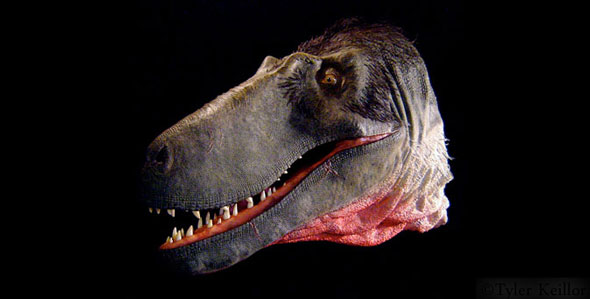

Tyler Keillor has been preparing fossils, creating skeletal reconstructions, and sculpting flesh models of prehistoric life at the University of Chicago since 2001. As a Paleoartist, he’s become known for the paleontological reconstructions he’s completed for The Discovery Channel, as well as scientists, museums and educational institutions around the world.
Recently, Tyler started a side-project on his own, aiming to build the most realistic reconstruction of a Dryptosaurus that has ever been attempted. Since little is known about this prehistoric New Jersey native, with only a few bones discovered here and there, the project requires several steps to completion. And we were honored that, as one of the steps, Tyler included us.
This story’s best told by starting at the beginning.
While little is known about the existence of the approximately 67 million years old Dryptosaurus, we do know that the dinosaur was one of the first to be discovered in North America. While it is over 100 years since the original discovery, nothing more than fragmentary remains have been recovered for this particular species. However, recent discoveries of possibly related taxa, (like Appalachiosaurus), have helped develop a picture of what this dinosaur might have looked like.
In 2009, Tyler was tasked with sculpting a full-scale Dryptosaurus head for The Lake Country Discovery Museum in Wauconda, IL. His detailed sculpture is quite the sight to see, including a speculative feathery coat, a brightly colored throat wattle and a variety of fresh and healing scars.
Although he’s always used traditional sculpting methods to craft his pieces, Tyler is deciding to use digital technologies to push beyond the heads and busts he’s sculpted in the past. Collaborating with paleontologist Steve Brusatte, who recently published a study on the Dryptosaurus, and Thomas Carr of the Dinosaur Discovery Museum in Kenosha, Tyler is planning both digital and physical Dryptosaurus models.
Familiar with Exact Metrology from surface scanning projects at University of Chicago, Tyler decided that, instead of reinventing the wheel, he would attempt to meld the existing Dryptosaurus head sculpture with a digital body.
Using a Romer Absolute Si arm with Polyworks software, then both Polyworks and Geomagic software for post-processing and data clean-up, we were able to scan the head on-site at Tyler’s home studio, so he didn’t have to risk the sculpture being damaged while in transport. And since the ROMER Si arm scans at up to 30,000 data points per second, this was done in no time.
Using this combination of software and scanner, we were able to provide Tyler with a high accuracy, high-resolution digital model of his Dryptosaurus sculpture, which he can then incorporate into his chosen software, Z-Brush, for digital sculpting of the remaining body.
Using digital technology, Tyler is no longer limited by size and scale like he was with past sculptures, yet will still keep complete control over the work, as if he was using clay, to sculpt in every detail.
"Exact Metrology’s scan turned out beautifully, capturing even intricate details,” explained Tyler. “The digital data has saved me a lot of time and effort and is exactly what I wanted."
Once the digital file is complete, it can be used on its own as a slide, an animation or as a still in a video presentation. The file can also be 3D printed to use as a prototype.
Tyler and Exact Metrology’s Michael Trudeau created a video of the ROMER SI arm dinosaur scan, which is included here. And Tyler even created a model of this for us, which is currently on display at our Brookfield office.
We’re happy we could be a part of Tyler’s Jurassic adventure and thank him for including us on the project. Now we’re just looking forward to meeting our first Dryptosaurus face to face.





